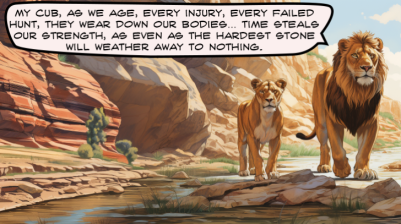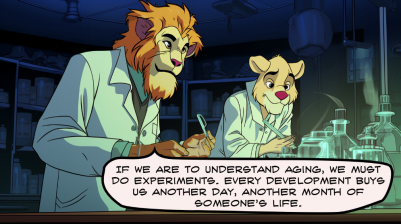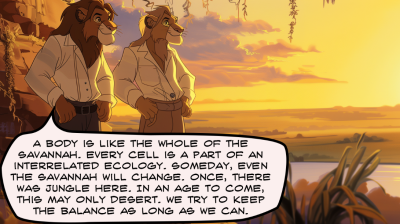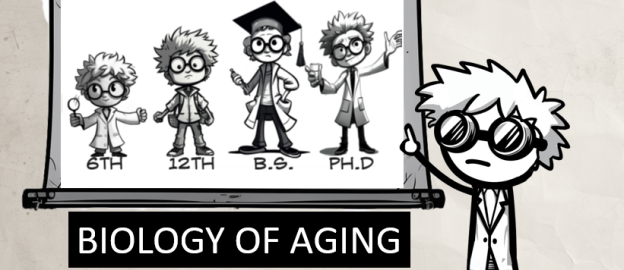I posted two videos in March:
Using electroluminescent film as a lightbox for tracing: https://youtu.be/ygrJ_BAm_Kg
Aging biology at 4 levels: https://youtu.be/9_JTit5J9zo
The second one was a doozy, here’s the edited-for-text version.
Aging biology at 4 levels
It all started with a video by CGP Grey called “Why Die?” that came out in 2017. I have been thinking about it and researching the topic of aging ever since. The video explains “what is aging?” at four different levels of complexity. The hope is that if we can understand aging as well as we understand, for instance, bacterial infection, maybe we can do something about it.
My conclusion is that Systems Biology is going to be the key to understanding aging. Systems biology is based on similar principles to Ecology, so that leads naturally to making an ecosystem analogy. Hence, the “Circle of Life.” At each level of complexity, I made a silly animated Lion comic.
I used Midjourney and Dall-E and Adobe firefly to make these comics. And I even got a voice changer to change my voice to do a daddy lion impression. It’s definitely dollar-store generic daddy lion, but that’s the joke. Or that’s what I’m telling myself.

Level 1:
Level 1 is thinking in terms of Just-so stories. The just-so-story theory of aging is that it’s good, actually. The “Circle of Life” is a just-so story that tells us that we have to get old and die. It says that getting old is how we fit into the natural order, how we have a meaningful life. Just-so stories can be useful. A good story can help contextualize a hard subject. But they can also be examples of superstition. They can hold us back. We don’t have to accept them.
Level 2:
Level 2 Thinking is cause-and-effect.

This is more useful, but still too simple. Aging is not the effect of a single cause. There’s nothing wrong with a simplification for non-professionals or non-specialists. But all simplifications are inherently incomplete.
Colloquially, we talk about our bodies “wearing out.” It’s a hypothesis that makes some sense… But if we were mechanical, like cars, less active people would live longer (it’s not the years, it’s the mileage). But that’s not true at all. People who exercise more tend to live longer, actually.
Another cause-and-effect level hypothesis is “Aging is caused by Telomere shortening.” Telomeres get shorter every time cells divide, so we tend to have shorter telomeres in old age. When they get too short, the cells can’t replicate, and they die. But it turns out that cells can rebuild telomeres under some circumstances… so it’s not just a simple timer that runs out.
We could talk about the free radical theory of aging, too, but I cut that for time. In a nutshell, free radicals are reactive molecules. They react with and destroy pretty much whatever they touch. Our cells make them, and then have to soak them up before they damage something important. One hypothesis is that the damage from free radicals slowly accumulates and we call that “aging.” So antioxidants (which help remove free radicals) should help mitigate aging. But antioxidants have a very small (if any) effect on aging. Doubling antioxidants definitely doesn’t cut aging in half.
In short, simple linear thing-causes-aging is probably too simple.
Level 3:
Level 3 is statistics. In the video, I use “smoking causes cancer” as an analogy. Smoking causes cancer, but it’s about risk and odds, not simple cause-and-effect. It turns out that smoking also accelerates aging, so it’s a useful inroad to statistical thinking and Kaplan Meier curves.

The K-M curve is how scientists can test anti-aging drugs. We can find something that changes with age, find a drug that reverses the change, then watch what happens to people on the drug. Statistically, do they live longer? The K-M curve shows whether the drug slowed aging or not. We WANT to see a big difference, but anything that bends the curve is a good thing.
Level 4:
The fourth level of understanding is Systems Biology. If aging can be ‘cured,’ the work will happen at the systems level and not at the simpler levels. What is systems biology? We are still talking about experimental science, but the causes and effects are more inter-related. The math of systems biology was inspired by ecology – the study of the relationships in nature.

A system is a collection of smaller things that relate to each other. Like how the immune system is made of lots of different kinds of cells. Or how the healthcare system is made of doctors and nurses and hospitals (and, in the US, insurance companies). Or the eco-system is made of plants and bugs and prey and predators.
Systems biologists measure many things with “omics” experiments (genomics for DNA, proteomics for protein, etc.). Then they use computer simulations to try to explain all of the measurements. I used a game like Sim City (or Civilization, etc.) to illustrate.
The rules are simple – put different kinds of blocks down to help your simulated people grow and succeed. You need to put residential blocks for people to live in. Add commercial and industrial blocks for people to work. Add streets for people to get between the two. But every choice affects the next choices. What you build and where you build it will change what options you have next.
To some extent, SimCity reflects problems in real cities. How we play the game in the early stages will create EMERGENT PROPERTIES like traffic. Traffic is not a monster that arrives to destroy your city like Godzilla. It’s a property of the organization of where people live and where they work. It emerges from the design of the city.
If we can get the game to reflect reality, we can do experiments in the game instead of real life. Small changes can have big, non-obvious outcomes and we can run the experiment in the computer FIRST (so we don’t screw up the real city).
And we can study much more complex properties this way, properties that are inconvenient to measure in real systems. If we get the rules of the simulation right, and we lay out the simulated city in the same way, we might learn how to solve traffic problems. We simulate re-zoning, or adding public transportation, or increasing gas taxes, or carpool lanes. If our model is accurate, we can tell which ones are more likely to work and which are probably dead ends.
If traffic is an emergent property of a city, Aging is an emergent property of our bodies. To solve it, we need to understand the parts, AND we need to understand their relationships. It’s not enough to understand that free radicals, DNA damage, and inflammation are associated with aging. We need to know how one is related to the other in time and space.
I based a fair amount of this on reading “Systems Biology” by Voit and a bunch of papers. Several papers by Alan Cohen and coworkers stood out. The insight that really stuck with me went something like this example: Free radicals are poisons that cause biological damage, but they are also a useful tool for biology. It is not a simple A-causes-B relationship (i.e., radicals = bad). Radicals are part of a pattern, like one instrument in a song or one token in a complex game. When the state of the game is such that a stable pattern is no longer achievable, homeostasis breaks down and the organism dies.
Aging is not one bad THING, it’s a bad PATTERN made of otherwise good things that we need.
It may be that all the hallmarks of aging (frailty, senescent cells, inflammation, stem cell exhaustion, telomere shortening) all cause each other! How confusing! How do we get to the root of the problem? Or, if there is no root, how do we intervene in everything all at once? The only chance we have for that project is to have a really good simulation of the whole system. If we understand how that works, we might be able to restore the system to something more like a young, healthy system.
Further Reading:
Voit, Eberhard O. Systems Biology: A Very Short Introduction. Oxford University Press, 2020.
Cohen, Alan A. “Complex Systems Dynamics in Aging: New Evidence, Continuing Questions.” Biogerontology 17 (2016): 205–20. https://doi.org/10.1007/s10522-015-9584-x.
Cohen, Alan A., Luigi Ferrucci, Tamàs Fülöp, Dominique Gravel, Nan Hao, Andres Kriete, Morgan E. Levine, et al. “A Complex Systems Approach to Aging Biology.” Nature Aging 2, no. 7 (July 2022): 580–91. https://doi.org/10.1038/s43587-022-00252-6.
Dato, Serena, Paolina Crocco, Nicola Rambaldi Migliore, and Francesco Lescai. “Omics in a Digital World: The Role of Bioinformatics in Providing New Insights Into Human Aging.” Frontiers in Genetics 12 (2021). https://www.frontiersin.org/articles/10.3389/fgene.2021.689824.
Knyazer, Anna, Gabriela Bunu, Dmitri Toren, Teodora Bucaciuc Mracica, Yael Segev, Marina Wolfson, Khachik K. Muradian, Robi Tacutu, and Vadim E. Fraifeld. “Small Molecules for Cell Reprogramming: A Systems Biology Analysis.” Aging (Albany NY) 13, no. 24 (December 17, 2021): 25739–62. https://doi.org/10.18632/aging.203791.
Loscalzo, Joseph, and Albert-Laszlo Barabasi. “Systems Biology and the Future of Medicine.” Wiley Interdisciplinary Reviews. Systems Biology and Medicine 3, no. 6 (November 2011): 619–27. https://doi.org/10.1002/wsbm.144.
McCormick, Mark A., and Daniel E.L. Promislow. “Recent Advances in the Systems Biology of Aging.” Antioxidants & Redox Signaling 29, no. 10 (October 2018): 973–84. https://doi.org/10.1089/ars.2017.7367.

